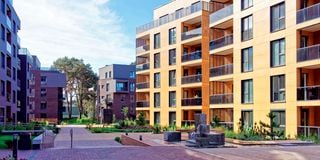Premium
The evolution of Kenya’s retail real estate industry

Over the past decade, Kenya’s retail real estate industry has experienced significant transformation, with a number of factors, ranging from advances in technology, crises such as the Covid-19 pandemic and a shift in buyer preferences, driving this change.
Over the past decade, Kenya’s retail real estate industry has experienced significant transformation, with a number of factors, ranging from advances in technology, crises such as the Covid-19 pandemic and a shift in buyer preferences, driving this change.
Whereas some five to 10 years ago one would see a lot of developers taking on major projects such as shopping malls, with large supermarket chains coming in as anchor tenants, development seems to have shifted to focus on smaller neighbourhood stores.
In 2023 for instance, only about two shopping malls including Eastleigh’s Business Bay Square Mall, have so far been opened in Nairobi, a sharp contrast from the number of convenience outlets being put up.
According to a recent study by Estate Intel and Axis Real Estate on Nairobi’s retail pipeline, more than 64 percent of major retail developments in the city are on hold due to low demand and an over-supply.
Convenience
Nickson Otieno, the Director of Trimax Architects and CEO of Niko Green, says that when the Covid-19 pandemic hit, a lot of buyer habits started to change. People would work from home, and so found it easier to do shopping nearby.
“We saw an emerging scenario where people wanted to get that convenience close by. Now that they did not have to work from 8am-5pm, Monday to Friday, they no longer needed a weekend to do shopping, perhaps for the entire week,” notes Otieno.
Even after the pandemic, many of these customers still preferred the convenience of shopping in their neighbourhood stores, therefore, to keep up with the market, developers had to start focusing on convenience retail projects.
“Any person that goes into business knows that for them to be successful, they have to focus on what the client wants. So, if the client's needs are changing, then you change,” says Otieno.
Consumers still expect to get the same items from their local convenience stores as they did from the mall, and so designers and developers are having to come up with layouts that enable the retailers to fit in as many products as possible, whilst still enabling consumers to shop in a socially-distanced manner.
Ashmi Shah, the retail portfolio manager at Knight Frank Kenya, says that tenants who previously would not be considered for convenience retail centres such as fashion designers are also moving towards convenience retail. Others are opticians, pharmacists, coffee shops and gyms.

Ashmi Shah. She is the Retail Portfolio Manager at Knit Frank Kenya.
However, though a lot of tenants and buyers seem to be moving towards convenience retail, Ms Shah points out that there are quite a number of tenants who still want to remain in the big malls, and for a good number of reasons. One of the reasons is that big malls guarantee more security, especially for businesses looking for 24-hour operability. Some tenants would also want to go for the malls since the presence of other traders increases the number of customers they can access. For customers, the availability of a variety of product offerings continues to be a lure.
“Even in situations where hyper convenient retail has come up and been very successful, we are still seeing a pull to be in a traditional mall, even for people who are in and out of the mall very quickly. That’s because of the level of facilities and options available. For convenience, clients may get tired of the same product offerings,” notes Ms Shah.
Environmental Social Governance considerations
Nickson Otieno, of Niko Green, says that in recent years, growing awareness on issues around health and wellness, as well as climate change has led to the adoption of sustainable practices by developers in retail real estate.
Power efficiency and waste management are elements that have become critical, and therefore some developers are leveraging the use of smart building technology to incorporate features such as automated lighting to reduce energy consumption.
“People want spaces that will contribute to their well-being, people are beginning to ask what are you doing in terms of your corporate social responsibility, what are you providing to people,” notes Otieno.
The architect says that besides just public opinion, other factors such as economics are also pushing developers to adopt sustainable practices. Since just like hospitality, retail is a sector that touches more on the user experience, developers have realised that investing in ESG can raise the value of an asset, as well as improve tenant retention.
“If you look at the most recent malls, a number of them are going for the green building certifications. One of the reasons for this is because of brand value. Big brands coming to look for space expect to have green certified spaces because they know the benefits that come with such spaces. They are even willing to pay higher rent,” notes Otieno.
He notes that ESG strategies also help to reduce operational costs, as buildings that do not have environmentally conscious features tend to be susceptible to rising utility costs, or indeed sharp state penalties.
“Look at an element like energy saving for instance-most of these retail spaces are very big, so if you are able to save even one shilling per square metre and we are talking of several square metres, for the developer this is one assured source of income,” notes Otieno.

Nickson Otieno.
Developers are also rushing to adopt ESG strategies to unlock green financing. ESG conscious investors will generally tend to provide more capital, with more favorable repayment terms to firms that can prove they practice sustainable development.
“There is a growing pool of climate finance and accessing this finance requires that developers have a very clear outline of ESG considerations in their projects,” notes Otieno.
Technology
Ashmi Shah, of Knight Frank Kenya, says that like most other sectors of the economy, technology has also become a major disruptor in the retail sector. Non-traditional models such as online shopping have become a major competition for conventional retailers, with businesses that have incorporated digital models into their operations finding it to be a growth channel for them.
“Some businesses are having large portions of their sales coming from online delivery, so the question for them is, should we still remain in the malls, or can we still serve our customers in a cheaper environment with a similar quality of products,” notes Ms Shah.
She adds that small retailers who never had an online presence are now starting to ask questions about how they can set up one. Other tenants are now using their shops as showrooms or storage facilities for their online operations.
Mall space might be too expensive for people looking to capitalise on online shopping, but that hasn’t stopped these people from alternatively stocking up their apartments for instance, then delivering on demand.
“A lot of people during Covid-19 and even now cook out of their kitchens, or prepare other products in the house, then deliver to their customers,” notes Ms Shah.
She however points out that there are also others who conducted most of their operations online or on social media, but are now taking up shops in malls because there is that trust element in having a physical presence.
“These ones also know that when a customer walks into a shop, they are likely to walk out with more things than they had planned to purchase,” notes Ms Shah.
With a younger generation that tends to prefer convenience in the form of online delivery, to get essentials such as ready to eat foods, she points out that online shopping could become a major supplement for conventional shopping.
“People still want to feel the product, but with technology such as virtual reality becoming more mainstream in online shopping experiences, we could have another major disruptor,” notes Ms Shah.
Entertainment
During the pandemic, when customers wanted to go out during the weekend, they prefered to go far beyond their neighbourhood, and avoided crowded spaces such as malls for entertainment. Savvy developers were keen to capitalize on this trend, which persists to date.
A good example of a development that has been inspired by this trend is the Safari centre in Naivasha, which targets travelers who may want to stop and do some shopping as they drive along the Nairobi Nakuru highway.
Ashmi Shah however notes that the larger malls still provide that daily or frequent solution for a lot of visitors, looking for things such as recreation.
In the selection of sites, developers are also becoming proactive in identifying the new places that revelers are coming together, and are putting up retail outlets nearby to serve this group.
“For instance, people will go somewhere for entertainment, and because there is not enough parking, they will go park in the retail center, after they’re done with the entertainment place, then they go back to the retail and shop,” notes Ms Shah.
Location
Meanwhile, Otieno says that developers are also now having to take into consideration the dynamics of the neighbourhood that they are putting up retail space.
In areas that are dense for instance, parking is not much of a requirement, because the shoppers are walking up to the retail developments. Regardless of how densely populated the area is however, developers are also having to consider the income levels of the people living there.
“In essence the question would be, why build large footprint development in a neighbourhood that would cost you Sh600- Sh800 million plus, then struggle to fill it,” notes Otieno.
In densely populated informal settlements, he says large formal retailers often struggle to balance between the money they spend putting up their structures, and the returns they get after.
That is because the amount of money that a consumer can spend here is much lower compared to what a consumer in a more affluent neighbourhood can, and yet the retailer has to maintain a similar standard of building and pricing on products, regardless of the location.
“In informal settlements, when you put cabro blocks for instance in front of your mall, you will find traders displaying their merchandise, right outside the mall and you cannot chase them away. For smaller retailers, the amount they need to earn to get a return on investment is very little compared to larger retailers, that’s why smaller shops thrive in informal settlements,” notes Otieno.
Flexibility of use
In an industry where buyer preferences seem to change often, Otieno says developers will have to be more flexible in their approaches, taking on mixed-use concepts for instance, so that in case retail has less of a demand, then it is easier to change functionality, from malls to furnished apartments for instance.
“You do not want to be stuck with space which does not have the flexibility for conversion, because buyer preferences will change regularly, and who knows what will happen in the next 10 to 20 years.
Some retailers who initially started as a supermarket are now purchasing the land around them and putting up residential blocks, so that they also get to benefit from a mixed used concept,” notes Otieno.





